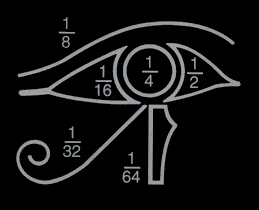|
The Falcon God »Horus« The eye of the Falcon God Horus is represented as a
human eye, however, the remarkable black mark and the arrangement of
the plumage as birds of prey have it are stylised at the lower section.
According to the old myth, the rivalling god Seth tore Horus' eye out.
Seth was his uncle, who contended with him for the Egyptian throne
after he had killed and dismembered his father, Osiris. Thot, the wise
moon god and the patron of the sciences and the art of writing, put it
patiently back in order and healed it. As an ambiguous symbol, it
describes the status of regained soundness: In the field of astronomy
it is the moon symbol absolute and refers to the increasing completion
of the moon disk; in the ideology of the Pharaonic kingdom it
represents the eternal renewal of the divine kingdom from king to king.
Wherever a state of weakness or disturbance could undermine the natural
order of things, the picture of the symbol with its power of magic
protection stabilises their right course again and, as a message of
hope, strengthens the faith of Egyptian thinking in the eternally
returning restoration of universal harmony. For this reason, the
Egyptians Maria Carmela Betrò |
 loved this symbol very much.
In the most different sizes and degrees of preciousness of its
materials, it served as an amulet worn around the neck or as a graphic
motif for beautiful jewels; it decorated the lunettes of stelae and
sarcophagi; it was part of auspicious picture mysteries in the ornament
of receptacles or other personal objects. It was also used for a pretty
graphic design of the units for grain. The value of a fraction was
assigned to each individual part of the eye which Seth had torn up
according to the myth. Their total, corresponding to the restoration of
the eye brought about by Thot, should have added up to a whole. In
fact, however, the total of the six fractions used results in only
63/64; it was assumed that Thot had withheld the missing 1/64 by
magic.
loved this symbol very much.
In the most different sizes and degrees of preciousness of its
materials, it served as an amulet worn around the neck or as a graphic
motif for beautiful jewels; it decorated the lunettes of stelae and
sarcophagi; it was part of auspicious picture mysteries in the ornament
of receptacles or other personal objects. It was also used for a pretty
graphic design of the units for grain. The value of a fraction was
assigned to each individual part of the eye which Seth had torn up
according to the myth. Their total, corresponding to the restoration of
the eye brought about by Thot, should have added up to a whole. In
fact, however, the total of the six fractions used results in only
63/64; it was assumed that Thot had withheld the missing 1/64 by
magic.